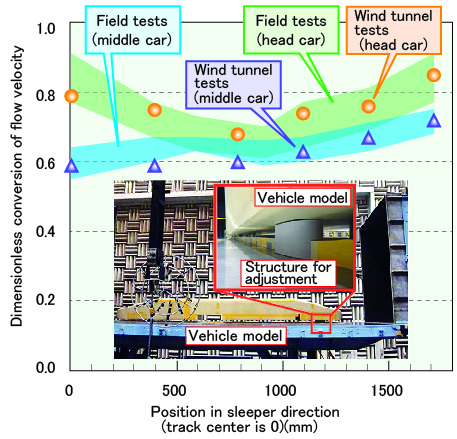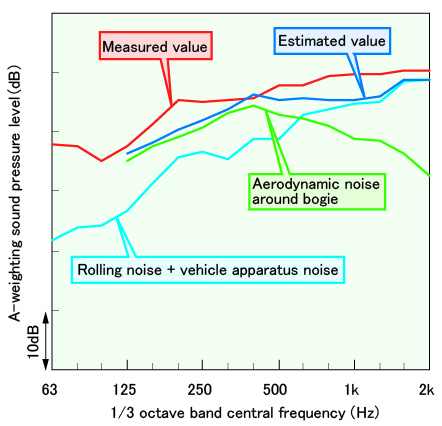3. Development of an experimental method using a wind tunnel to evaluate underbody aerodynamic noise
- A method was developed to reproduce in a wind tunnel the flow velocity profile of the underbody of a real Shinkansen train.
- The developed method makes it possible to quantifiably evaluate aerodynamic noise from the bogie area.
Progress has already been achieved in finding solutions to aerodynamic noise from Shinkansen trains, especially from pantographs and other upper body parts. However, noise emitted from the train underbody has also been increasing relatively, therefore reducing this noise is now a growing source of concern. Therefore the flow velocity profile for the underbody of a real Shinkansen train was reproduced in wind tunnel tests and a method was developed to perform a quantitative analysis of the aerodynamic noise produced in the bogie area.
A hot-wire anemometer was installed on a commercial railway line in order to measure the vehicle underbody velocity flow components in the rail direction and sleeper direction. A device was designed to regulate the velocity flow of the underbody on the model vehicle used in the wind tunnel, making it possible to develop a method for reproducing the velocity flow profile of a real train. (Fig 1). Confirmation was obtained that this method allows accurate reproduction of velocity flow profiles measured in field tests.Fig.1). Using this method, aerodynamic underbody noise is measured in the wind tunnel. Another method is used to estimate the contribution of rolling noise which is then added to obtain the overall underbody noise close to the rail. The difference between estimated and measured noise is less than3dBvalidating the applicability and appropriateness of this method.(Fig.2). In addition to this, it was found that for speeds of over 300km/hand at frequencies under 500Hz bogie aerodynamic noise accounted for the majority of overall underbody gear noise.
In future, this method can therefore be applied for estimating the aerodynamic noise from bogies, with a view to finding countermeasures to this problem.

Fig.1 Shinkansen underbody flow velocity profile
(flow velocity elements in the rail direction looking
from the train)
Fig.2 Comparison of measured and
estimated underbody aerodynamic noise
(point close to rail at 320 km/h)